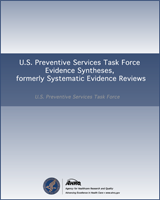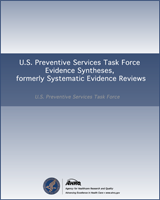NCBI Bookshelf. A service of the National Library of Medicine, National Institutes of Health.
This publication is provided for historical reference only and the information may be out of date.
Structured Abstract
Background:
Obesity, a condition characterized by excess body fat, carries substantial health implications for both chronic disease and mortality. This fact and its increasing prevalence make obesity an important health problem.
Purpose:
To examine the evidence of the benefits and harms of screening and earlier treatment in reducing morbidity and mortality from overweight and obesity.
Data Sources:
We developed an analytic framework and 6 key questions that represent a logical chain between screening and sustained weight reduction and reduced morbidity and mortality. We searched MEDLINE from January 1, 1994 (the end date for prior USPSTF searches), to July 31, 2001, using the Medical Subject Heading obesity and overweight and combining this term with predefined strategies to identify relevant English-language studies. We also searched the Cochrane Library, contacted experts, and scanned review bibliographies. We found 4 recent, well-conducted systematic reviews and relied on their analyses of the studies they included.
Study Selection:
We included: (1) large, population-based surveys of the prevalence of overweight and obesity; (2) randomized controlled trials (RCTs) with at least 1 year follow-up (6 months for pharmacological studies) reporting weight reduction or health outcomes for treatment and harms questions. The shorter follow-up period for pharmacological studies was driven by the available literature: weight loss trials were frequently only of 6 months' duration but were complemented by studies designed specifically to evaluate maintenance of that loss. When we found few or no RCTs, we examined cohort studies concerning the efficacy or harms of treatment. Two reviewers examined all abstracts and articles to determine which met inclusion criteria.
Data Extraction:
Two reviewers abstracted relevant information from each article, using standardized abstraction forms. We graded the quality of all included articles according to criteria established by the U.S. Preventive Services Task Force.
Data Synthesis:
No RCT of screening for obesity has been performed. Obesity is most commonly measured as body mass index (BMI, weight in kilograms [kg] divided by height in meters squared). Although other measures have been developed, BMI is the most consistently used in the literature, and so we focused on it as the preferred screening tool. The prevalence of obesity (BMI ≥30) has been increasing; currently; at least 27% of the adult population is obese. The prevalence of overweight (BMI 25–29.9) is about 34%. Among people with BMI of about 30 or greater, intensive counseling and behavioral treatment for obesity is effective in reducing mean weight by about 3 kg to 5 kg after 1 year. Pharmacotherapy with sibutramine or orlistat is also effective in reducing mean weight by about 3 to 5 kg. For people with BMI of 35 or greater, surgical therapy leads to dramatic reductions in weight of 20 kg or more.
Both counseling-based and drug-based maintenance interventions were helpful in retaining weight loss. Weight reduction of 5% to 7% body weight is associated with lower incidence of diabetes, reduced blood pressure, and improved dyslipidemia. Larger weight loss has been linked with more dramatic improvements in glycemic control and lipids in limited surgical outcomes data.
We did not find evidence evaluating potential harms of counseling-based interventions. Sibutramine is sometimes associated with increased blood pressure (mean increase of 0–3.5 mm Hg); orlistat causes gastrointestinal distress in 15% to 37% of people taking the drug. Surgical procedures lead to mortality in less than 1% of patients in pooled samples, but in up to 25% patients re-operation is necessary over 5 years.
Conclusions:
Screening with BMI would detect a large percentage of adults who are obese or overweight. Limited evidence suggests that counseling interventions may promote modest weight loss in the overweight (BMI 25–29.9). Effective treatments for people with BMI >30 include intensive counseling and behavioral interventions for lifestyle change, and pharmacotherapy. Surgery is effective in reducing weight for people with BMI of 35 or greater. Adverse effects include increased blood pressure and gastrointestinal distress with drugs and a small percentage of serious side effects with surgery
Contents
- Preface
- Acknowledgments
- 1. Introduction
- 2. Methods
- 3. Results
- Key Question No. 1: Does Screening for Overweight and Obesity Affect Health Outcomes?
- Key Question No. 2: What is the Prevalence of Overweight and Obesity?
- Key Question No. 3: Is There a Reliable and Valid Screening Test?
- Key Question No. 4a: Do Any Interventions Lead to Sustained Weight Reduction?
- Key Question No. 4b: Do Interventions Improve Other Intermediate Health Outcomes?
- Key Question No. 5: Do Interventions Improve Final Health Outcomes
- Key Question No. 6: What are the Harms of Screening and Treatment?
- 4. Discussion
- Appendix A. Evidence Tables
- Appendix B. Counseling Intervention Descriptions
- Appendix C. Descriptions of Intensive Counseling and Behavioral Intervention Studies
- References
Prepared for: Agency for Healthcare Research and Quality, U.S. Department of Health and Human Services.1 Contract No. 290-97-0011, Task No. 3, Technical Support of the U.S. Preventive Services Task Force. Prepared by: Research Triangle Institute/University of North Carolina Evidence-based Practice Center.2
This report may be used, in whole or in part, as the basis for development of clinical practice guidelines and other quality enhancement tools, or a basis for reimbursement and coverage policies. AHRQ or U.S. Department of Health and Human Services endorsement of such derivative products may not be stated or implied.
AHRQ is the lead Federal agency charged with supporting research designed to improve the quality of health care, reduce its cost, address patient safety and medical errors, and broaden access to essential services. AHRQ sponsors and conducts research that provides evidence-based information on health care outcomes; quality; and cost, use, and access. The information helps health care decisionmakers—patients and clinicians, health system leaders, and policymakers—make more informed decisions and improve the quality of health care services.
The authors of this report are responsible for its content. Statements in this report should not be construed as endorsement by the Agency for Healthcare Research and Quality or the U.S. Department of Health and Human Services of a particular drug, device, test, treatment, or other clinical preventive service.
- 1
540 Gaither Road, Rockville, MD 20850. www
.ahrq.gov - 2
3040 Cornwallis Road PO Box 12194 Research Triangle Park, NC 27709.
- Review Screening and Interventions for Childhood Overweight[ 2005]Review Screening and Interventions for Childhood OverweightWhitlock EP, Williams SB, Gold R, Smith P, Shipman S. 2005 Jul
- Review Behavioral and Pharmacotherapy Weight Loss Interventions to Prevent Obesity-Related Morbidity and Mortality in Adults: An Updated Systematic Review for the U.S. Preventive Services Task Force[ 2018]Review Behavioral and Pharmacotherapy Weight Loss Interventions to Prevent Obesity-Related Morbidity and Mortality in Adults: An Updated Systematic Review for the U.S. Preventive Services Task ForceLeBlanc EL, Patnode CD, Webber EM, Redmond N, Rushkin M, O’Connor EA. 2018 Sep
- Review Lipid Screening in Childhood for Detection of Multifactorial Dyslipidemia: A Systematic Evidence Review for the U.S. Preventive Services Task Force[ 2016]Review Lipid Screening in Childhood for Detection of Multifactorial Dyslipidemia: A Systematic Evidence Review for the U.S. Preventive Services Task ForceLozano P, Henrikson NB, Morrison CC, Dunn J, Nguyen M, Blasi P, Whitlock EP. 2016 Aug
- Review Behavioral Counseling to Promote a Healthy Lifestyle for Cardiovascular Disease Prevention in Persons With Cardiovascular Risk Factors: An Updated Systematic Evidence Review for the U.S. Preventive Services Task Force[ 2014]Review Behavioral Counseling to Promote a Healthy Lifestyle for Cardiovascular Disease Prevention in Persons With Cardiovascular Risk Factors: An Updated Systematic Evidence Review for the U.S. Preventive Services Task ForceLin JS, O'Connor EA, Evans CV, Senger CA, Rowland MG, Groom HC. 2014 Aug
- Review Lipid Screening in Childhood and Adolescence for Detection of Familial Hypercholesterolemia: A Systematic Evidence Review for the U.S. Preventive Services Task Force[ 2016]Review Lipid Screening in Childhood and Adolescence for Detection of Familial Hypercholesterolemia: A Systematic Evidence Review for the U.S. Preventive Services Task ForceLozano P, Henrikson NB, Dunn J, Morrison CC, Nguyen M, Blasi PR, Anderson ML, Whitlock E. 2016 Aug
- Screening and Interventions for Overweight and Obesity in AdultsScreening and Interventions for Overweight and Obesity in Adults
Your browsing activity is empty.
Activity recording is turned off.
See more...

